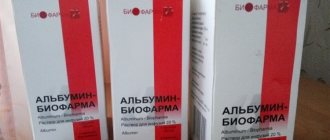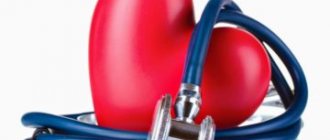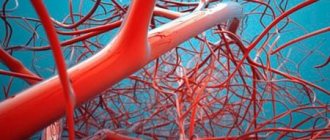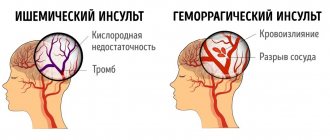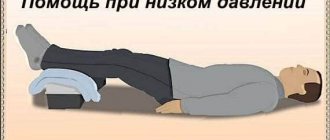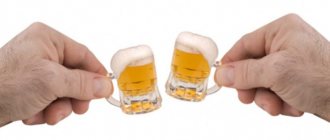It is worth noting that only a qualified specialist can make a correct diagnosis. If the patient notices 1-2 symptoms, this does not indicate the presence of the disease. This is only discussed when there are 4–6 or more symptoms. It is important to get into the hands of a normal specialist who distinguishes VSD from other diseases.
Muscle symptoms
With VSD, a person often experiences pain or spasms in the muscles. This happens because the nervous system cannot cope with its functions. Due to a malfunction of other organs, the muscles do not receive enough microelements (potassium, magnesium). This can lead to unpleasant sensations such as cramps. Spasms and muscle pain are common.
Muscle pain due to VSD
Muscle tension and pain with VSD are a common problem. They occur on the muscles of the arms and legs (more often). Limbs hurt in the evening or at night. The sensations can be strong, so the person cannot sleep. This is due to the fact that during the day the limbs become very tired. It happens that painful sensations appear during the day, when muscle tension is at the side of the aisle.
Spasms during VSD
Tight muscles affect other tissues and nerve endings. This causes seizures. Often a person feels numbness or tingling in the legs. Sometimes the tension is very strong and the patient does not control the work of the muscles: he cannot turn his head or does not control the movement of his eyelids. This occurs with severe nervous tension. When the condition returns to normal, all functions return to normal.
What to do about the problem?
Treatment can only be prescribed by a qualified specialist.
The problem can be solved with medication. Several drugs can be distinguished, which are presented in the table:
It is necessary to consult a doctor, do all the tests, undergo examinations - ECG, MRI. Following your doctor's recommendations will help you cope with discomfort. It is important not to overwork, have regular, long sleep, eat properly and balanced (the body must have all the necessary vitamins and minerals). It is necessary to completely eliminate alcohol and smoking. Bad habits destroy nerve endings, which can aggravate the situation. It is useful to take a contrast shower. This will help relieve tension and tone the muscles.
Doctor of Medical Sciences, specializing in neurology, professor. Doctor of the highest qualification category. Medical experience over 25 years.
Area of professional interests: acute and chronic pain (osteochondrosis, back pain, joint pain, headaches, neuralgia, etc.). Acute and chronic vascular diseases (stroke, discirculatory encephalopathy, consequences of strokes, arterial and venous disorders, vegetative-vascular dystonia, etc.), asthenic conditions, chronic fatigue, memory impairment, attention, neurotic disorders, etc.), traumatic brain injuries. Difficult cases. The author's methods of quickly working with the patient's subconscious, restoring his internal resources.
Pain during VSD is the main complaint presented by patients. Their localization and intensity vary. The difficulty in making a diagnosis lies in the need to exclude other causes of such sensations.
VSD can cause pain of varying degrees.
How long does it last?
Based on their length, crises are divided into three categories: mild, moderate, and severe.
- A mild crisis lasts less than half an hour and has virtually no aftertaste.
- Moderate and severe degrees of crisis last about an hour and several hours, respectively, and have varying durations of asthenia.
But no matter how long the first attack of neurocircular dystonia lasts, the person who suffered it will remember this horror for the rest of his life: a frantic heartbeat is accompanied by the inability to breathe deeply, the ground disappears from under his feet, his hands and feet become cold, his vision becomes dark. And after a few minutes of this state, the patient is overcome by a feeling of imminent death.
From this moment on, the life of every person who has suffered a vegetative-vascular crisis changes radically. The patient lives in anticipation of a repetition of this nightmare, constant tension, endless trips to doctors, nervous tension, all this negatively affects both the physical and psychological state of the patient.
Pain syndrome and VSD
The autonomic nervous system influences the functioning of various organs. Muscle pain in VSD and other parts of the body cannot be ignored; it is necessary to consult a doctor for timely treatment.
Sometimes the patient develops vegetative body aches, but continues to endure discomfort and does not seek medical help. Gradually, the discomfort intensifies, and taking painkillers does not help to cope with them. With severe pain, a panic attack may occur, which is difficult to get rid of.
Non-drug approach
Lack of normal sleep with VSD is treated with psychotherapy and physiotherapy, as well as alternative medicine methods.
Psychotherapeutic treatment is carried out by a doctor, sometimes in parallel with drug treatment, sometimes without it. There are a large number of techniques and techniques aimed at eliminating the problem that causes insomnia. Good results are given by:
- Cognitive-analytical therapy helps to get rid of destructive thoughts and find an acceptable model of behavior;
- art therapy helps to get rid of stress, especially caused by tragic events;
- Gestalt therapy builds on the natural desire to be healthy and helps break down blocks that disrupt the natural cycle of wellness.
Physiotherapeutic procedures are prescribed by a doctor and carried out in specialized institutions. For VSD accompanied by insomnia, the following is used:
- Massage. This procedure restores blood circulation, relaxes muscles, and is useful for relieving nervous tension. For dystonia, the most important area for massage is the collar area.
- Magnetotherapy. For insomnia, the procedure is performed in the head and neck area. It stabilizes blood pressure, improves blood circulation, and increases vascular tone.
- Electrosleep. Electrodes are placed on the eyelids and low-frequency currents are sent to the brain. During the procedure, the patient is immersed in a state similar to sleep, during which brain function is normalized.
- Darsonvalization. When combating lack of sleep and other manifestations of VSD, the procedure is performed in the head and neck area. Improves blood circulation, relaxes blood vessels and strengthens the body's immunity.
- Bath. This procedure can be performed at home. For complete relaxation, you need to lie in a warm bath with the addition of decoctions of sedative herbs or essential oils.
Alternative medicine recommends herbal treatment. Various decoctions and tinctures from soothing herbs, a healthy lifestyle and quality rest are especially capable of coping with simple forms of the disease.
Causes
Dystonia is accompanied by various symptoms, including the appearance of discomfort. They do not always have a clear localization; in most cases, migration is noted (in the morning a burning sensation in the lower extremities, in the evening - migraine).
Causes causing clinical manifestations:
- a pathological process formed in the brain leads to the appearance of pulsation;
- pain is associated with an imbalance between parts of the nervous system;
- under the influence of psychological problems, nerve endings perceive symptoms distorted (minor itching is felt as severe pain).
the tone of small vessels is disrupted, which leads to a deterioration in the blood supply to certain parts of the body, causing discomfort;
Any manifestations, including pain in the legs, with VSD, are characterized by volatility: unpleasant sensations change localization during the day.
Painful symptoms can appear in various places:
Sometimes patients experience unpleasant sensations throughout the body simultaneously, their intensity varies.
Leg pain
Pain and weakness in the legs are all symptoms of vegetative vascular dystonia. Why does autonomic dysfunction more often lead to disorders in the lower and upper extremities?
There are several reasons for this:
- disruption of the correct process of contraction of vessels located on the periphery (leg veins);
- changes in the functioning of valves in blood vessels, which causes hemodynamics to suffer and heaviness and pain in the legs to occur;
- high physical activity causes muscle pain.
Important! Pain in the legs related to VSD is never accompanied by the occurrence of edema. If the latter appear, then most likely the problem is varicose veins, injuries or pathologies of the heart and kidneys.
In order to clarify the diagnosis, a person suffering from leg pain must undergo the following examinations:
- X-ray;
- ultrasonography;
- magnetic resonance imaging;
- computed tomography.
It should be remembered that a feature of autonomic disorders is the manifestation of a burning sensation in the limbs, limited mobility, which occurs with flexion or extension.
Types of pain
Pain in autonomic disorders is polymorphic and develops differently.
- Increased discomfort after stress, anxiety, worries. A panic attack can be a provoking factor.
- Varying intensity.
- Migration of painful sensations and absence of signs of organ damage.
- The effect of taking sedatives, not analgesics.
Symptoms of VSD.
The location of the discomfort affects the location of the affected organ. In most cases, the heart and blood vessels are affected, so patients most often complain of a burning sensation in the chest, tingling in the heart, and migraines.
Back and neck pain
There are many reasons that can cause neck and back pain, so it is necessary to determine the triggering factor.
The main reasons are:
- osteochondrosis of the cervical or thoracic spine;
- violation of metabolic processes;
- degenerative changes in the intervertebral discs, causing severe pain;
- psychological problems.
Muscle and joint pain
Pain in muscles and joints have features that distinguish dystonia from diseases of other organs:
- muscle spasms appear as a result of the influence of provoking factors, after the disappearance of which they disappear;
- varying intensity of pain;
- symptoms constantly change localization;
- The use of tranquilizers rather than painkillers gives a greater effect.
If muscle pain occurs, additional examination is necessary. In the absence of pathologies from the musculoskeletal system, manifestations are associated with autonomic disorders.
These symptoms are accompanied by:
- feeling of stiffness;
- burning;
- minor cramps of the limbs.
Pain throughout the body
A characteristic complaint of patients is discomfort, in which unpleasant sensations spread to the entire body. This is associated with severe dysfunction of the autonomic nervous system and the development of psychological personality changes. Patients tend to exaggerate symptoms (sometimes they perceive irritating factors as a strong threat to health).
Pain throughout the body
With VSD, patients often complain of various painful sensations spreading throughout the body, but many do not know why the whole body hurts. The reason for this is dysfunction of the ANS system and psychological changes in the patient. Pain may appear in the chest, lower back, back, legs, or the right or left side may hurt. Abdominal pain with VSD is quite common and can cause diarrhea, belching, and intestinal pain.
A common headache is that it occurs as a result of poor circulation and improper functioning of the blood vessels in the brain.
Pain from VSD can spread throughout the body. The autonomic system controls the functioning of all internal organs, and its disruption leads to serious malfunctions and wandering pains.
The manifestation of any pain syndrome during VSD indicates the need for examination. If, when diagnosing a patient with such a clinical picture, no other diseases are identified, then we are talking about dystonia.
How to treat
The pain syndrome that occurs with vegetative-vascular dystonia does not disappear with the use of standard medications (antispasmodics and painkillers do not bring relief).
Since the cause of discomfort is disturbances that occur in the activity of the nervous system, complex therapy is required to eliminate the symptoms. Medicines are used that have a calming effect on the nervous system and relieve fear.
- taking herbal decoctions and infusions that have a calming effect (valerian, motherwort);
- nootropic drugs (to stimulate blood flow and improve brain activity);
- sedatives;
- tranquilizers (for increased anxiety, panic attacks, severe emotional stress);
- hypotensive (for high blood pressure).
Treatment must be prescribed by a doctor; self-medication may result in serious consequences.
Prevention of insomnia
“I can’t sleep normally,” many modern people turn to doctors with this problem. Inadequate sleep is often the result of causeless anxiety and emotional turmoil provoked by VSD. But what to do in such a situation?
You need to learn to control your internal state, and for this you need to follow certain recommendations.
- You should not watch TV until late, surf the Internet, or read books with a creepy plot or difficult-to-read content.
- You can't overeat in the evening. Dinner dishes should be appetizing and easily digestible.
- It is advisable to take a shower or bath before going to bed.
- In the evening, you should not eliminate troubles or sort things out. It is better to postpone these unpleasant activities until the next morning.
If the above measures do not help cope with insomnia, then you should definitely go to a medical specialist. Only competent and timely treatment of VSD will help avoid serious health problems.
Insomnia is a curse for any person. Sleep disturbances lead to a decrease in cognitive (cognitive) and behavioral dysfunctions, as a result of which the general psychological state worsens and performance decreases. The causes of insomnia often lie in the area of neuralgia and psychogenic disorders, so this article will discuss the most common of them. What to do with insomnia and depression? How to treat insomnia with neurosis? What steps should you take to ensure you never have sleep problems again in your life?
Causes and types of pain in dystonia
Pain due to VSD in most patients manifests itself in adolescence. At first, their intensity remains quite low, so many people prefer to endure the discomfort. However, with age, the pain syndrome progresses and can significantly worsen the quality of life.
VSD is a symptom complex indicating a multifunctional disorder of the autonomic nervous system. The most common causes of pain are:
- Pathological nociceptive impulses. Due to an imbalance between the sympathetic and parasympathetic divisions of the ANS, the brain receives distorted information about the state of the body.
- Disorders of contractions of small vessels. When it is prolonged, the blood supply to individual organs and parts of the body deteriorates. Pain is a signal that tissues are not receiving enough oxygen and nutrients.
- Psychosomatic factor. If a medical examination fails to diagnose physiological disorders, most likely the cause of the pain syndrome is the emotional state of the patient.
Many patients identify clear triggers - factors that provoke the occurrence of unpleasant sensations. These include:
- stress, psychological or physical stress;
- infectious diseases;
- injuries;
- unbalanced diet;
- incorrect daily routine;
- alcohol;
- smoking.
Heredity plays a significant role: symptoms observed in parents, in most cases, also appear in children.
Interrelation of concepts
Insomnia (insomnia) and vegetative-vascular dystonia are inextricably linked, because one is the cause of the other. Night rest disorders manifest themselves in different ways and have 3 main types:
- frequent waking up;
- inability to sleep;
- complete lack of sleep.
Most people suffering from this disease complain of poor sleep during VSD. The main reason is that the center of the brain responsible for producing melatonin refuses to do its job correctly. And this hormone is a regulator of circadian rhythms, and its deficiency leads to disturbances in the phases of wakefulness and rest.
Patients often experience nightmares, and dysfunction during sleep in the form of apnea, tachycardia, tremor, fever or chills, etc. also affects most patients with vegetative-vascular dystonia. Sometimes a person sees vivid dreams, but they are short-lived and lead to a sharp awakening.
To improve the quality of night's rest, it is necessary to avoid provoking factors before bedtime.
Symptoms of pain in vegetative-vascular dystonia
A feature of VSD is the clear dependence of physical sensations on emotions. Most often, discomfort is caused by strong negative feelings: fear, anger, anxiety. Moreover, the nature of the pain directly depends on their intensity. Patients also note a deterioration in their health due to panic attacks.
Other signs indicating damage to the autonomic nervous system:
- Imaginary. There are no objective reasons for poor health, that is, tests, ultrasound or MRI for vegetative-vascular dystonia do not reveal any pathologies.
- Change of localization. Depending on external factors and the patient’s mood, discomfort may manifest itself in different parts of the body.
- Varying intensity. If with somatic diseases unpleasant sensations increase gradually, then in the case of VSD this happens chaotically. Mild discomfort can suddenly turn into unbearable pain and vice versa.
Symptoms resulting from overstimulation of the nervous system may decrease or disappear completely after taking sedatives.
What happens during an attack of VSD at night?
Such attacks do not have constant clinical symptoms and occur quite often. More often the heart and blood pressure fluctuations make themselves felt, that is, a cardiovascular appearance is observed. At this point, it may appear that the person is having a fever or a heart attack. The following symptoms are observed:
- the body is “pounding”, the head is heavy;
- the lungs do not have enough air;
- a panic attack occurs (fear and horror appear);
- have depressive thoughts;
- there is a rapid heartbeat;
- pressure may jump;
- there is a burning sensation and severe pain in the heart area;
- very dizzy;
- limbs become numb or cold;
- Enuresis occurs in children.
As a rule, night attacks occur around 3 am.
Types of pain
Discomfort with vascular dystonia can occur in different parts of the body. The most vulnerable are: the heart, blood vessels of the head, muscles of the back and neck. The largest number of nerve fibers is concentrated there. Differential diagnosis allows you to identify symptoms that have a vegetative origin.
Back and neck pain
Most often, pain in the neck and back is caused by osteochondrosis - a degenerative lesion of the intervertebral discs, in which they lose their elasticity and pinch the nerve endings of the spinal cord. Metabolic disorders and emotional disorders characteristic of VSD further increase the resulting discomfort.
Muscle and joint pain
To diagnose autonomic dysfunction, it is necessary to exclude the presence of organic lesions of the musculoskeletal system. Physical sensations caused by injury or infection are constant, whereas patients with VSD report sharp fluctuations in intensity.
There is also no stiffness in movement: despite the discomfort, a person is able to fully perform any exercise. At the same time, sedatives help cope with the problem much better than analgesics.
Pain throughout the body
This symptom indicates a deep damage to all parts of the nervous system, which has developed over many years. At the same time, such patients have progressive psycho-emotional disorders and a tendency toward hypochondria—an exaggeration of unpleasant symptoms.
Bone pain
Damage to the blood vessels and nerves of the bones during dystonia develops extremely rarely, so the final diagnosis is made only after a complete examination, excluding the presence of inflammatory processes and oncology.
Leg pain
The lower limbs bear the weight of the entire body, so even minor circulatory disorders provoke discomfort and heaviness. With VSD, these symptoms are associated with improper contraction of peripheral vessels and valve apparatus, which leads to stagnation of blood in the veins. Unlike varicose veins, autonomic disorders do not cause edema.
We recommend checking online to see if you have hidden varicose veins. From slight fatigue and heaviness in the legs to swollen veins and blue-burgundy stars is just one step.
What should sleep be like with VSD, its normalization
1. An evening walk at an average pace with a slowdown before its completion is effective. The walk should be long enough until you get slightly tired.
2. Sometimes a 10-15 minute warm salt bath helps you fall asleep, promoting maximum relaxation and relieving the stress accumulated during the day. Baths can be different - with salt, valerian, pine. Of course, there are contraindications, such as heart disease.
3. Normal sleep is facilitated by a hot foot bath for 15 minutes, which can improve blood pressure measurements in some people with high blood pressure. Sit on a chair, put your feet in a basin of warm water, and add hot water from the kettle, guided by your own feelings. Very quickly the blood partially drains from the head, and it becomes much lighter.
4. For insomnia, ordinary relaxation and autogenic training are ineffective. Lying in bed, you need to gradually relax your body, starting from the tips of your toes, while talking about something pleasant.
You can even imagine yourself floating in the blue sky - associations may change. Breathing is easy. You can practice breathing with a long, warm exhalation, focusing on. After 15–20 minutes, sleep almost always sets in.
5. It is advisable not to watch horror films, thrillers and melodramas, as well as news channels at night. Better to read something. Sometimes short reading makes you drowsy.
6. Some people find that drinking a glass of warm milk with honey before bed helps them fall asleep; in general, honey relaxes the nervous system well.
7. Don’t set yourself the goal of sleeping 7–8 hours; normal sleep duration varies from person to person; there are many people who sleep very little and still always feel good. And there are some for whom even 10 hours is not enough to get enough sleep.
It is very often noticed that if a person sleeps for six hours, then he is in a state of goodness. People who sleep 10 hours or more, on the contrary, are often in a state of passion and ignorance. Sometimes even by how much a person sleeps, one can judge his character and preferences.
A person who experiences reasonable physical activity at work usually does not experience problems falling asleep or experiences them extremely rarely. If there is no adequate sleep during VSD, the course of the disease worsens and the symptoms are more pronounced. Sometimes, napping during the day causes insomnia. In these cases, it is better to exclude this rest option. In general, there is no need to be afraid of insomnia. It is the fear of it that is harmful, not the insomnia itself. If you don’t get enough sleep one night, you’ll fall asleep the next – more fatigue will accumulate, and then sleep will certainly come.
Vegetovascular dystonia is a pathology that develops due to improper functioning of the nervous system. Today the disease is considered widespread. It is diagnosed mainly in people who are constantly exposed to stressful situations and who are physically and mentally overtired. Insomnia with VSD is observed in almost all cases and negatively affects the well-being of sick people. Why a pathological condition occurs and how to deal with it are questions that require answers from qualified specialists.
Muscle and joint pain
Muscle or joint pain in VSD has certain features, which makes it possible to exclude organic pathology of these structures:
- Instability. Discomfort disappears after normalization of the patient’s emotional state and elimination of the provoking factor. Infection, injury or other pathology is characterized by persistent pain.
- Marked fluctuations in pain intensity.
- There are no restrictions on the range of movements. Despite the discomfort, the patient can perform any exercise fully.
- Migration of pain. “Wandering” pain is often found in patients with VSD.
- Greater effect from treatment using sedatives than analgesics.

